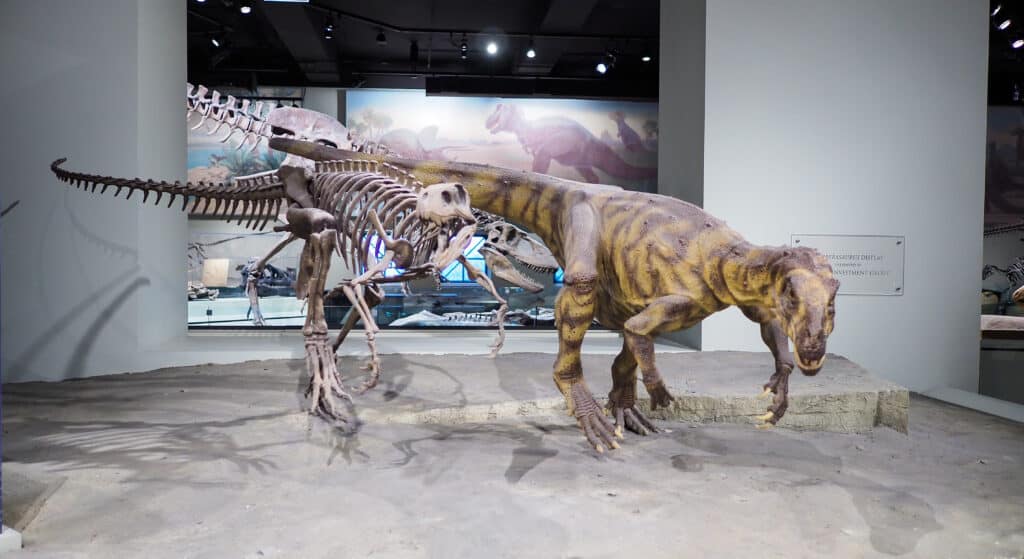Herrerasaurus
Herrerasaurus ischigualastensis
Herrerasuarus was one of the earliest dinosaurs in fossil records
Advertisement
Herrerasaurus Scientific Classification
- Kingdom
- Animalia
- Phylum
- Chordata
- Class
- Reptilia
- Order
- Dinosauria
- Family
- Herrerasauridae
- Genus
- Herrerasaurus
- Scientific Name
- Herrerasaurus ischigualastensis
Read our Complete Guide to Classification of Animals.
Herrerasaurus Conservation Status

Herrerasaurus Facts
- Prey
- Pisanosaurus, Synapsids and rhynchosaurs
- Fun Fact
- Herrerasuarus was one of the earliest dinosaurs in fossil records
- Most Distinctive Feature
- Herrerasaurus had long and muscular hind limbs but had short forelimbs
- Distinctive Feature
- Long and muscular tail
Herrerasaurus Physical Characteristics
- Weight
- 770 lbs
- Height
- 10 ft
- Length
- 20 ft
- Venomous
- No
- Aggression
- Medium
View all of the Herrerasaurus images!
Herrerasaurus is a genus of primitive dinosaurs that lived in Northwestern Argentina around the Late Triassic, about 228.7 million to 199.6 million years ago. This prehistoric dinosaur represents the first fossil of a dinosaur or a close relative in the fossil records. The discovery of this group of dinosaurs is quite significant to paleontologists because it provided major insights into the evolution of the dinosaurs, such as what the early dinosaurs looked like and when they evolved.
Description & Size
This ancient reptile was a genus of ancient dinosaurs that lived during the Late Triassic. It was one of the earliest dinosaurs in the fossil record. The name “Herrerasaurus” means Herrera’s lizard. The dinosaur was named after the rancher who discovered it in 1958. Paleontologists have only found one species, Herrerasaurus ischigualastensis, so far.
Scientists believe that dinosaurs actually descended from the Herrerasaurus, owing to their many shared characteristics, Though it lacked the leg and hip bones of the dinosaurs. While the hip structure of this dinosaur was similar to that of the saurischian dinosaurs, the arrangement of the bones is more similar to that of the ancestral archosaurs.
The Herrerasaurus was fully bipedal with strong hindlimbs. The forelimbs were smaller, measuring less than half the length of the hindlimb. Herrerasaurus had a relatively small head with a skull about 56 centimeters (22 inches) long. The total length of the dinosaur, including its long tail, was about six meters (2 feet) in total, and it weighed about 350 kilograms (770 pounds).
Herrerasaurus probably moved swiftly. Its lightweight build and partially stiffened tail gave the dinosaur an incredibly balanced body. The hindlimbs had long feet with five toes. However, only the middle three toes bore the dinosaur’s weight.
One major distinction between the Herrerasaurus and its dinosaur relatives was its skull. Herrerasaurus had a long, narrow head that looked more like that of primitive archosaur. The Herrerasaurus’ flexible jaw was similar to that of many lizards today. The flexible jaw design allowed the Herrerasaurus to grasp prey more easily. It also had large teeth with serrations for biting and cutting flesh.
Diet
Scientists studied the Herrerasaurus‘ teeth and concluded that this ancient dinosaur was a carnivore. Based on its size, experts think it must have preyed on small and medium-sized animals that lived in the same periods. While the ancient dinosaur’s precise prey isn’t known, experts think it might have included dinosaurs like the Pisanosaurus and the plentiful synapsids and rhynchosaurs of the time. Findings from the examinations of fossilized dung found in the same rock formation in which Herrerasaurus was found are consistent with the theory that this dinosaur was a carnivore.
Habitat
The few fossils of the Herrerasaurus found so far were discovered in Late Triassic rocks in the Ischigualasto Formation in San Juan, Argentina. Paleoenvironmental studies conducted to determine the nature of this environment in ancient times show that it was a volcanically active floodplain with a thriving forest that received seasonal rainfall. The climate at the time would have been moist and warm.

No one really knows what the Herrerasaurus really looked like, but models can give us an idea.
©Pao W/Shutterstock.com
Threats and Predators
The Herrerasaurus lived alongside other ancient dinosaurs that were smaller and fewer that wouldn’t have posed a major threat to their existence. However, massive non-dinosaurian reptiles were present at the time, as well, and there’s a good chance that the Herrerasaurus were preyed upon by giant reptiles such as the Saurosuchus. Herrerasaurus lived when the earth’s ecosystems were experiencing dramatic environmental changes, which could have been a major threat to their existence as well.
Discoveries and Fossils
Victorino Herrera, a rancher, discovered the first fossil of the Herrerasaurus in 1958. The fossil was named after him. It was an incomplete fossil, and scientists thought it was probably a basal theropod, sauropodomorph, or saurischian based on early studies.
30 years later, paleontologists discovered a more complete fossil. This find included a complete skull and a few other bone fragments. This allowed them to reconstruct the Herrerasaurus. Paul Sereno published a comprehensive description of the dinosaur in the Journal of Vertebrate Paleontology based on the 1988 discovery.
Extinction: When Did It Die Out?
The Herrerasaurus lived during the Late Triassic. During this time, there were quite a few large dinosaurs. Herrerasaurus accounts for 10% of the total number of fossils discovered at the Ischigualasto Formation. However, the period was a time of major ecological changes, and the dinosaurs soon evolved to become the dominant land animals, sharing many characteristics with their ancestors, the Herrerasaurus.
Similar Animals
Similar dinosaurs to the Herrerasaurus include:
- Sanjuansaurus: This is a small dinosaur species that lived during the Late Triassic. It was comparable in size to a medium-sized Herrerasaurus.
- Eoraptor: This is a genus of small basal sauropodomorph that lived in Argentina around the same time as the Herrerasaurus.
- Chindesaurus: This is a genus of basal saurischian dinosaurs that lived during the Late Triassic. It is the north-American equivalent of the Herrerasaurus, but it was slightly smaller.
Related Animals
View all 104 animals that start with HHerrerasaurus FAQs (Frequently Asked Questions)
When was the Herrerasaurus alive?
Herrerasaurus lived in South America during the Late Triassic . This was about 230 million years ago. This ancient dinosaur is one of the earliest dinosaurs in the fossil record. It went extinct about 199.6 million years ago.
How big was the Herrerasaurus?
Herrerasaurus was a lightly built carnivore. It weighed about 770lbs (350kg) and was about 20ft (6m) long on average. However, smaller specimens have been found that were about half of this size.
Was Herasaurus a meat eater?
Yes, Herrerasaurus was a carnivore. Studies of the dinosaur’s dentition and fossilized dung suggest it was an active carnivore.
Thank you for reading! Have some feedback for us? Contact the AZ Animals editorial team.
Sources
- britannica, Available here: https://www.britannica.com/animal/Herrerasaurus
- berkeley, Available here: https://ucmp.berkeley.edu/diapsids/herrerasaurus.html
- dbpedia, Available here: https://dbpedia.org/page/Herrerasaurus
- wikipedia, Available here: https://en.wikipedia.org/wiki/Herrerasaurus















